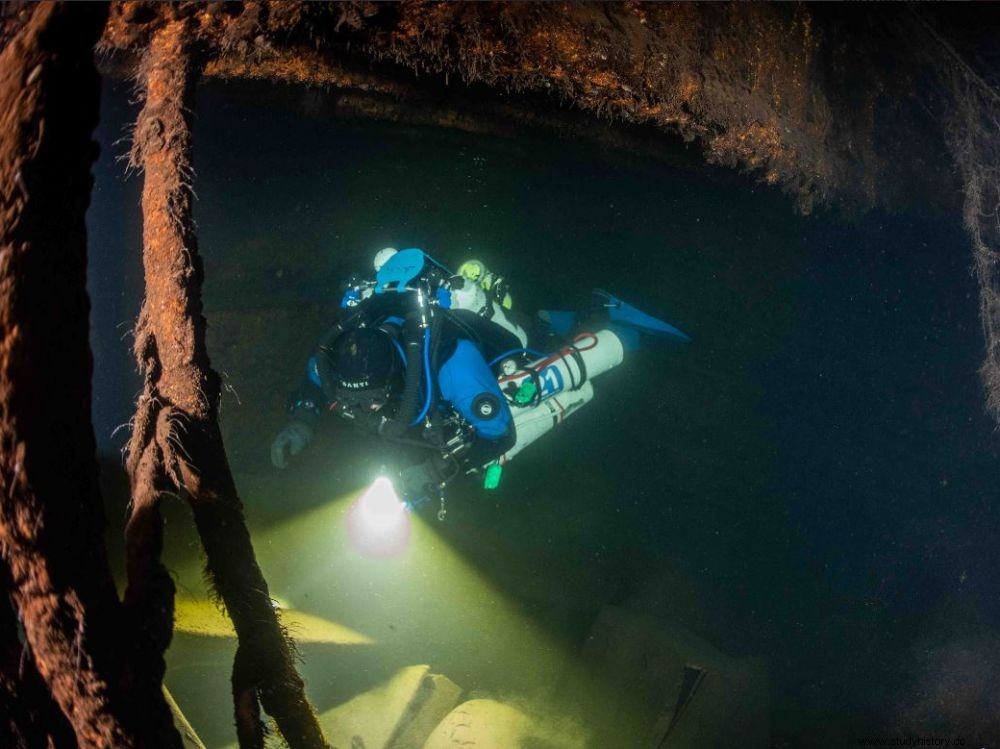Polish divers believe they have discovered the wreck of a German ship from the Second World War, which could contain legendary relics...

A diver above the wreck of the Karlsruhe, a steamship, sunk in the Baltic Sea in April 1945.
One of the great unsolved enigmas of this 20th century conflict is the disappearance of Catherine of Russia's fascinating "Amber Room" during World War II, a room completely decorated with amber resin plaques. Looted by the Nazis, considered lost, no one knows since 1945 what happened to it. However, a team of Polish divers from the Baltictech association, recently announced on its Facebook site that they had located the wreck of a German ship which could perhaps elucidate this mystery!

The only known color photo of the Amber Room, taken in 1917, at Tsarskoye Selo Palace, near St. Petersburg. ©Public domain
According to Tomasz Stachura, one of the members of Baltictech who answered questions for the British daily The Guardian , the almost intact wreck found at 84 meters deep, north of Ustka in Poland, would be that of the Karlshruhe , a steamer sunk in the Baltic Sea in April 1945 during a bombardment by Soviet aircraft. Still according to the statements of the diver, the holds of "the wreck would contain military vehicles, porcelain, and numerous crates with unknown contents" .

Remains of German military equipment, on the wreck of the Karlsruhe, at a depth of 84 m. © Baltictech
Access to several historical documents enabled these deep-sea explorers to discover that the Karlshruhe, had been part of Operation Hannibal, led by Admiral Dönitz. That is, for fifteen weeks (January 23 - May 8, 1945), one of the most colossal evacuations by sea of German civilian and military populations - historians mention two million people.
One of the great unsolved enigmas of this conflict of the 20 e century. Looted by the Nazis, considered lost, no one knows since 1945 what happened to it. However, a team of Polish divers from the Baltictech association, recently announced on its Facebook site that they had located the wreck of a German ship which could perhaps elucidate this mystery!

The only known color photo of the Amber Room, taken in 1917, at Tsarskoye Selo Palace, near St. Petersburg. ©Public domain
According to Tomasz Stachura, one of the members of Baltictech who answered questions for the British daily The Guardian , the almost intact wreck found at 84 meters deep, north of Ustka in Poland, would be that of the Karlshruhe , a steamer sunk in the Baltic Sea in April 1945 during a bombardment by Soviet aircraft. Still according to the statements of the diver, the holds of "the wreck would contain military vehicles, porcelain, and numerous crates with unknown contents" .

Remains of German military equipment, on the wreck of the Karlsruhe, at a depth of 84 m. © Baltictech
Access to several historical documents enabled these deep-sea explorers to discover that the Karlshruhe, had been part of Operation Hannibal, led by Admiral Dönitz. That is, for fifteen weeks (January 23 - May 8, 1945), one of the most colossal evacuations by sea of German civilian and military populations - historians mention two million people. At the time, everything that floated had been requisitioned, from warships to merchant fleets, including fishing boats, freighters and ocean liners, to form convoys and carry as many passengers as possible. Cornered in Königsberg, East Prussia (now the Russian enclave of Kaliningrad), German civilians as well as soldiers tried to escape the advancing Red Army. It is also there, in this same city, that archives dating from 1945 mention the presence of amber boxes for the last time. "If the Germans were to take the Amber Room across the Baltic, the Wasn't Karlsruhe their last chance?" , asks the Baltictech team.
After leaving the port of Pilawa on April 12, 1945, "with on board more than a hundred soldiers of the Hermann Goering regiment, and more than a thousand civilians, and tons of goods", the Karlsruhe would have was bombed and sunk in a few minutes, on the morning of April 13, 1945. Only a hundred passengers would have survived out of the 1083 embarked.
"Nazi treasures" always stimulate the imagination and are often the subject of whimsical research. Concerning the Amber Room, speculations have been very numerous since the end of the last world war. Some even mention their presence in mines, where they would still be buried.
 Portrait of Catherine II, former Empress of All Russia. Credits:Albert Albertrandi / Newscom/Sipa
Portrait of Catherine II, former Empress of All Russia. Credits:Albert Albertrandi / Newscom/Sipa
Catherine of Russia's amber-walled chamber was one of the most valuable rooms in the Imperial Palace at Tsarskoye Selo, south of Saint Petersburg (Leningrad), Russia. It had been offered by the King of Prussia Frederick William I st to Tsar Peter the Great of Russia in 1716. Dismantled by the Nazis, the six tons of amber coating that constituted it had to be taken to Germany. For most historians, these amber resin plates were probably destroyed during the bombings of 1945. Melted without a trace. However, some pieces from this treasure, probably stolen during the war - a mosaic and a chest of drawers - curiously reappeared in Bremen (Germany) in 1997… These items were later returned to Russia by the German Federal Government. Since 2003, visitors to St Petersburg have admired a copy of the Amber Room.
Could the bottom of the sea harbor more traces of this lost gem? Bold, Polish divers seem ready to believe it.
